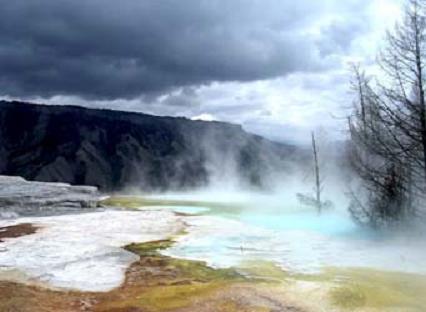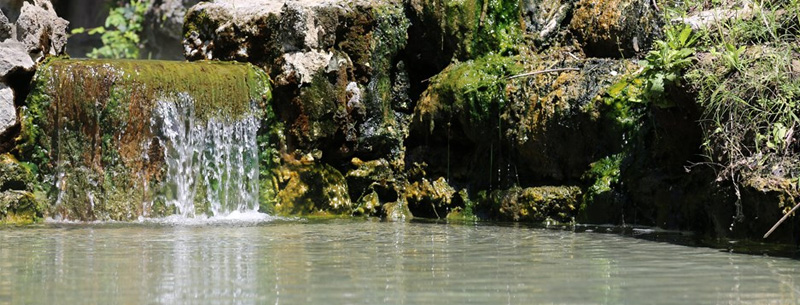Long known as the American Spa, Hot Springs National Park is a world-renowned destination due to the abundance of natural hot springs found in the area. In fact, the park boasts a staggering 47 springs that spurt forth almost one million gallons of virtually 100 percent pure hot spring water each day at a temperature of 147°F (64°C). For thousands of years, people have flocked to the springs eager to rejuvenate themselves in the thermal waters, leading many to consider the area America’s First Resort. During the 1800s, the widespread popularity of the springs led to the development of traditional bathhouses, making the Hot Springs area one of the most favored spa destinations in North America.
Today, Hot Springs is the only American city that is found within a national park, making it a truly unique destination. Not only does Hot Springs National Park feature a wide range of historic attractions for visitors to explore, but the park also makes an excellent home base when participating in the abundance of outdoor activities available in the area. It is important to note that since the park is located within and adjacent to the city of Hot Springs, the two are often referred to interchangeably. However, Hot Springs National Park is more specifically the protected and historic area of the city of Hot Springs.
Visiting Hot Springs National Park
Fifty miles southwest of Little Rock, the spa town of Hot Springs nestles in the heavily forested Zig Zag mountains. Hot Springs National Park is the oldest park currently in the National Park System. Its thermal waters have attracted visitors since Native Americans used the area as a neutral zone to settle disputes.

Even though the popularity of the park has waned over the years, it is still possible to sample the old-time luxury of Hot Springs by taking a bath. The only establishment on Bathhouse Row that is still open for business is the Buckstaff, where a thermal mineral bath costs $14. To taste the water, which lacks the strong sulphuric taste often associated with thermal springs, you can fill up a container at the drinking fountain at Central and Reserve.
To the rear of the Fordyce Bathhouse in downtown Hot Springs, two small springs have been left open for viewing. The Grand Promenade from here is a half-mile brick walkway overlooking downtown. Trails of various lengths and severity lead up to the steep slopes of the Hot Springs Mountain. To reach the summit, take a short drive or any of several trails. The observation decks of Mountain Tower offer superb views of the town, the Ouchitas, and the surrounding lakes.
In-Park Attractions
Hot Springs National Park Visitor Center
The Hot Springs National Park Visitor Center, located in the former Fordyce Bathhouse, is also home to a four-story museum. Visitors can explore the many rooms and exhibits preserved in the center, including the Men’s Bath Hall, which features a stunning stained glass ceiling entitled Neptune’s Daughter, which is made up of over 8,000 pieces of glass. Rooms once used for massage, mechanical therapy and hairdressing remain untouched, and visitors also enjoy viewing the bowling alley, music room and gymnasium. Tours of the museum are self-guided, but guided tours can be arranged in advance.
Bathhouse Row
Bathhouse Row is also a must-see when visiting Hot Springs National Park. This National Historic Landmark District features eight beautifully preserved bathhouses that were built between 1892 and 1923. Bathhouse Row is considered to be the greatest collection of bathhouses found in the United States. Located on Main Street, visitors enjoy strolling down the row and taking in the unique architectural style of the bathhouses. The Buckstaff Bath House is a great place to be pampered, as it is the only remaining operational bathhouse located within Hot Springs National Park. The bathhouse opened its doors in 1912 and continues to offer traditional treatments in the therapeutic hot spring water.
The Grand Promenade
Considered to be one of the most scenic trails in Arkansas, the Grand Promenade is a one-third-mile-long brick path that runs parallel to Bathhouse Row. Lined with trees and flowers, the path provides access to a number of scenic overlooks and also offers a peek of the protected springs. Picnicking is a popular pastime on the Grand Promenade, which is accessible from the Visitor Center and also from Fountain Street.
Hot Springs Mountain Tower
Originally built in 1877, Hot Springs Mountain Tower has been reconstructed three times, with the latest tower opened to the public in 1983. Standing 216 ft (66 m) in height, the tower is a great way to see Hot Springs National Park and the surrounding area. In fact, on a sunny day, visitors can reportedly see 140 mi (225 km) from the panoramic observation deck. Other sites that can be viewed from Hot Springs Mountain Tower are the mountains in the Ouachita National Forest and the Diamond Lakes region. The tower is located atop Hot Springs Mountain and there is an admission charge to ascend to the top.
Recreational Activities
Hot Springs National Park is an outdoor adventurer’s paradise. Approximately 26 mi (42 km) of day-use hiking trails are found within the park, offering spectacular views of the Ouachita Mountains. Hikers appreciate that mountain bikes are not permitted on the trails. Popular routes include those found on the West Mountain and the Hot Springs Mountain Trails. Other recreational activities in and around the park include camping, fishing, horseback riding, year-round water sports, golfing and crystal mining in nearby Mount Ida, Arkansas.
History of Hot Springs National Park
For nearly 10,000 years, American Indian tribes have flocked to the thermal hot springs found in what is present-day Arkansas. Celebrated for their soothing powers, the springs have long been considered a spiritual haven in which numerous American Indian tribes could congregate without conflict. In 1541, Spain’s foremost American explorer of the time, Hernando DeSoto, came across the springs and reveled in the supposed rejuvenating and healing powers that the water possessed. After DeSoto’s visit, Europeans were drawn to the springs, which consequently increased in popularity over the following centuries.
In the early to mid-1800s, the Hot Springs area became a first-class resort destination for those seeking the alleged health-giving waters. As a result, several full-service bathhouses were established on what is now named Bathhouse Row. Hot Springs, which was appropriately dubbed the American Spa, soon attracted the wealthy wishing to treat ailments ranging from rheumatism to circulatory dysfunction.
On April 20, 1832, Congress realized that in order to preserve the springs they must be protected and, as a result, the Hot Springs Reservation was founded. From then on, the springs flowing from Hot Springs Mountain were sheltered from overuse and exploitation. It is interesting to note that Hot Springs National Park is the oldest area currently found in the National Park System, although it did not officially become a National Park until March 4, 1921, after a congressional name change. Yellowstone National Park retains the title as the oldest national park since it was designated as such in 1872.
By the late 1800s, the bathhouses in Hot Springs rivaled those found in Europe. Those who could afford five-star service stayed in large, luxurious accommodations that featured top-of-the-line bathhouses, while less affluent spa enthusiasts visited smaller, less extravagant establishments. Eventually, the government offered free bathing for those without ample funds, provided the patient had a doctor’s note.
In the early 1900s, Hot Springs became known for its progressive health techniques, many of which accompanied the traditional bathing experience. When prescribing baths to their patients, some doctors also advised them to undergo hydrotherapy and electrotherapy treatments. A variety of therapeutic regiments were available at the spas, including the Sitz bath, the needle shower, the Scotch Douche, and electric baths, where low amp electrodes were sent through the bathwater in order to increase body tone and relieve stress.
Today, Hot Springs National Park protects eight historic bathhouses on Bathhouse Row that were used during the late 1800s and early 1900s. This area has been declared a National Historic Landmark District, as it houses the most prized collection of bathhouses in North America.
Arkansas Information
One of the southern states of USA, Arkansas is the birthplace of former President William Jefferson Clinton. Officially the name of the state is spelled “Arkansas” and pronounced “Arkansaw.” The most populous city of Little Rock is also the state capital and Eureka Springs and Hot Springs are its popular tourist destinations.
A great deal of geological diversity is found in Arkansas that is surrounded by six states with the Mississippi River making for a large stretch of the border on the eastern side. Also, there is vast mountainous terrain formed by Ozarks and the Ouachita Mountains.
With natural diversity, Arkansas offers something that truly interests one and all. It boasts of 52 State Parks that are each a unique and splendid site, offering perfect outdoor recreation for kids, families, adventure seekers, senior citizens, and nature lovers. Several state parks also have historic sites and museums and therefore it is a wonderful retreat for history lovers.
The diversity of wildlife in Arkansas needs a special mention as every region shelters some exclusive species of animals and birds. Notably, the state is situated right on the Mississippi Flyway, a path followed by millions of migrating ducks, geese, butterflies and other birds.
Major attractions include the Diamond Discovery Center, Murfreesboro – a public diamond mine, Pinnacle Mountain State Park in Little Rock, Anthony Chapel, and Hot Springs National Park, recognized as the oldest National Park in the nation, the stunning Winthrop Rockefeller Center located atop the Petit Jean Mountain and the Mark Martin NASCAR Museum situated in Batesville.
Modern amenities are available in plenty as Arkansas is also home to world-class spas, resorts, golf courses, and shopping centers. In short, Arkansas is the perfect place to discover the bounties of nature, while rejuvenating and unwinding.
